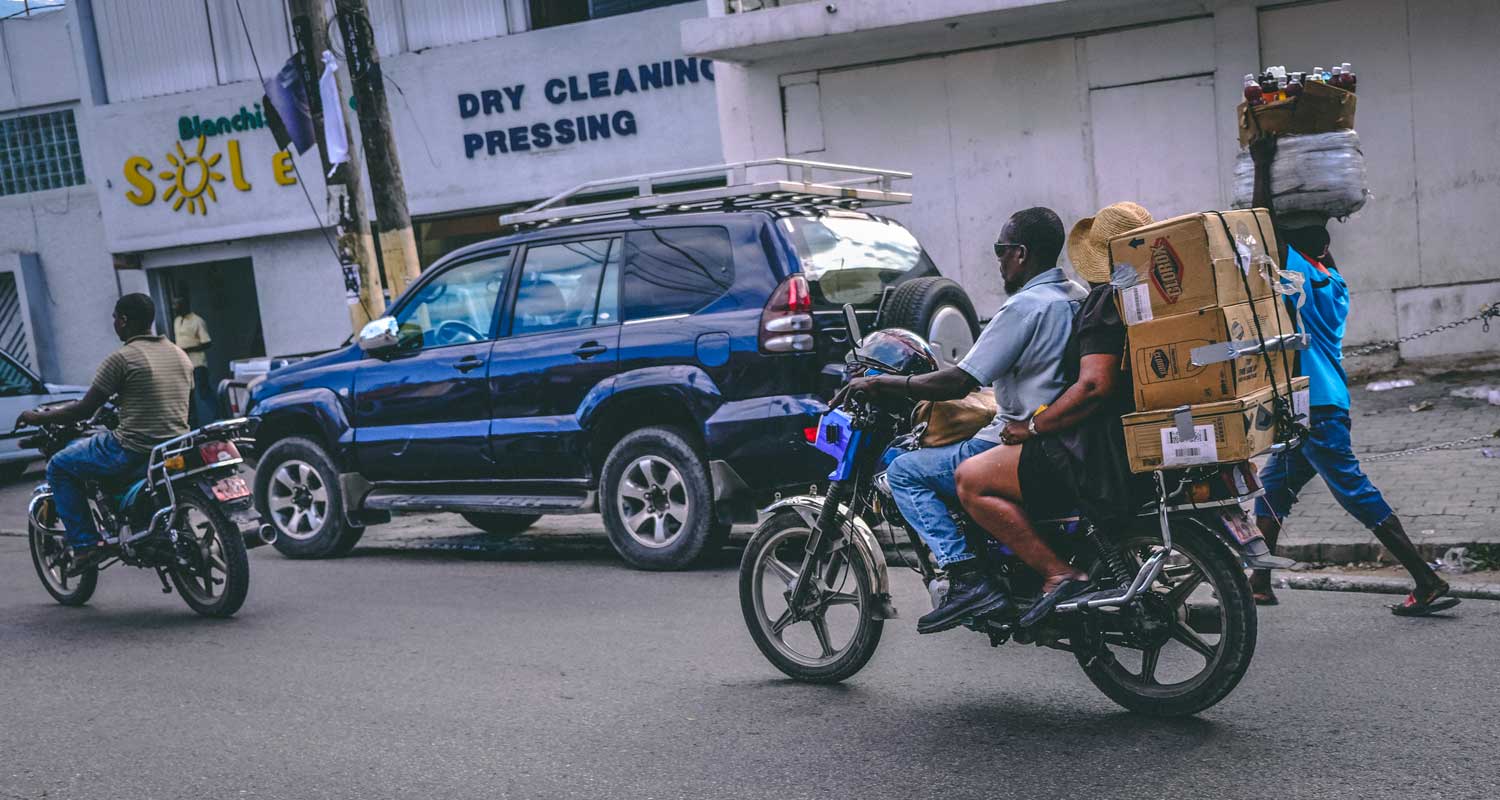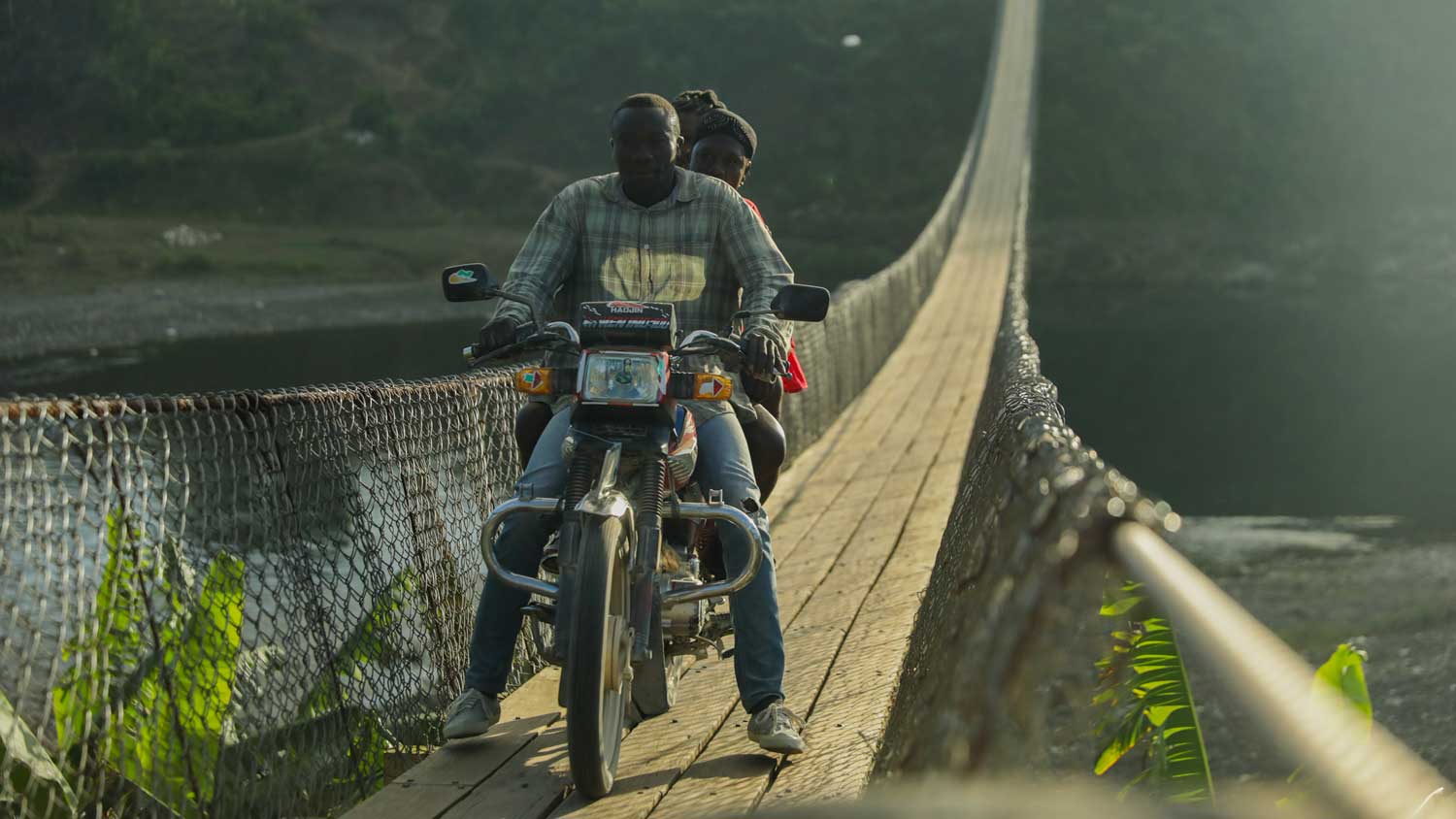Things to do
Getting around Haiti: How to Moto
Moto Taxi in Pétion-Ville, Port-au-Prince
Photo: Frank Fontain
Need a taxi? You won’t find big yellow cabs in Haiti but there will be one - or seven - “motos” ready to help you get around. Here’s how to spot one, flag one down, negotiate a fare and travel like a pro.
What is a moto?
The “moto”, short for motorcycle, is the most convenient mode of public transportation, picking you up and dropping you off at your precise location. Motos are a great alternative to the other popular form of public transport you’ll find: the Tap-Tap (literally “Quick-quick”), the cheerfully-painted minibuses that serve as share taxis which follow a predetermined route.
If you think you need a Tap-Tap because a moto won’t be able to fit your luggage on it, think again. 50-gallon drums, livestock, shelving units, solar panels, a family of five, construction materials, and another moto, are just some of the things that may be transported on a moto. It’s unlikely you’ll carry more than any moto in Haiti can handle.

Moto Taxis in Port-au-Prince
Photo: Frank Fontain
How to spot a moto
How can you tell which motorcycles are moto taxis? The simple answer is: you can’t, at first. There isn’t anything obvious that indicates which motorcycles are on the street to work as taxis and which are being used for private transportation. However, there are subtle things you can look for so that you don’t have to go around waving at every motorcycle that goes by. Here is a list of things to look for:
- -Moto taxi drivers are male. There are a few female motorcyclists, but if you see one, she probably isn’t a taxi driver. If she is a moto taxi driver, she might be Haiti’s first.
- -Moto taxi drivers are looking for you. They are scanning the sides of the roads, looking for a passenger. Usually people that are not a taxi, just look straight ahead at the road.
- -Moto taxi drivers won’t be in a uniform. Uniforms are for school or work, and if the driver of a moto is wearing a uniform, you can bet he isn’t a taxi.
- -Moto taxi drivers wear shoes, not sandals. The good ones wear glasses and a hat too.
- -Moto taxi drivers won’t have a backpack, tools, or other items carried on the moto.
- -Moto taxi drivers will stop when you wave them down.

Moto driver on bridge
Photo: Mikkel Ulriksen
How to flag a moto and negotiate a fare
To flag a moto down you simply wave your hand and, if the driver is available to pick you up, he will pull over for you. Before you swing a leg onto the moto, it’s important to negotiate the fare for your journey so that there is no misunderstanding between you and the driver when you arrive at your destination.
Be sure to verbalize which currency you are negotiating in so that there isn’t a mix up between the Haitian gourdes and the Haitian dollar, or the Haitian dollar and the US dollar. It is always best to have the correct change, as the drivers often don’t have change, or at least they might try to say they don’t have change, in hopes of being able to keep yours.
Once you’ve agreed on a destination and a fare, you want to hold onto your money (don’t pay your driver until you have arrived) and hop on the moto.

Moto driver
Photo: Mikkel Ulriksen
The right way to get on a moto
Make sure you stand on the left side of the moto and swing your right leg over. If you try to get on from the right side, you are likely to burn your leg on the muffler. That 3-inch diameter burn on your leg will scream “rookie” to the locals.
Be like the old pros and get on from the left side. There should be pegs by the back wheel for you to put your feet on and usually a small bar at the back of the seat for you to hold on to. Once you’re comfortable, the driver will depart, ready to take you wherever you need to go in Haiti.
It may sound strange compared to what you’re used to, but for Haitians the moto is a way of life. So wave one down, negotiate a price, hop on from the left side, and enjoy the sights, sounds and smells of the streets, with a little wind in your hair, until you’ve reached your target location. It’s the quickest, easiest, and best way of getting around Haiti.
Categories
Tags
Share
Categories
Tags
Share
4 reasons why Haiti is an adventure
Travellers exploring the Kaskad Pichon waterfalls, Haiti
Photo: Frank Fontain
Explore more of Haiti
Soup Joumou – the taste of freedom
This once-forbidden stew now symbolises independence. Find out what makes
Seven Haitian Businesses and Brands You Should Know
We're giving you the lowdown on Haiti’s top entrepreneurs and
The Seven Best Books about Haitian Vodou
Dive into the mystical realm of Haitian Vodou with our
Ten of the Best Books about Haiti
Cosy up with these ten books that explore the fascinating
Fiercely independent – Haiti has attitude
From eighteenth century revolution to twenty-first century carnival, Haiti’s personality
Check out These 10 Amazing Haitian Birds
Did you know that you’ll see more Caribbean birds in
Experience Haiti Virtually from Your Home
Join us and take a virtual walk through Haiti's forests,
A Visual Guide to Vèvè: Vodou Symbols & Cosmograms
Discover the intricate art of Vodou symbols with our visual
Meet the Locals: Haitian Actor Jimmy Jean-Louis
Haitian actor Jimmy Jean Louis takes us through his favorite
Subscribe to our newsletter
Get more travel inspiration, tips and exclusive offers sent straight to your inbox

